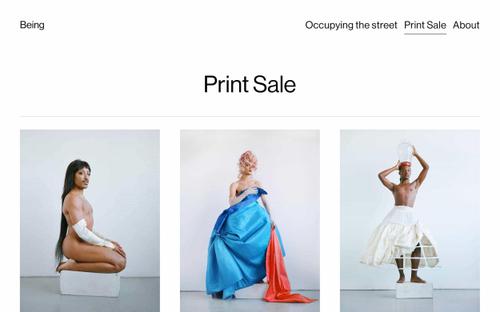Starting a new project? Download our free workbook to build your brand with confidence.
The email you entered is invalid.
Thank you for subscribing.
By entering your email, you indicate that you have read and understood our Privacy Policy and agree to receive marketing from Squarespace.
For the last decade, Squarespace has been a fixture at the Big Game, showing millions of viewers the many ways you can use Squarespace to build a beautiful website, sell your products or services, and more.
During this year’s game, we debuted “A Tale As Old As Websites,” a short film starring Barry Keoghan and his donkey as they spread websites and opportunity across the idyllic Irish countryside.
We tapped two of the creative minds behind the project—Nate Skinner, Senior Director of Brand and Creative Strategy, and Wes Falik, Staff Producer—for a peek behind the curtain at how Squarespace brought this major advertising moment to life, and lessons even the newest brands can learn from the team’s approach.
Brainstorming with purpose
For Squarespace, the Big Game ad is an “all hands on deck” project. Brainstorming starts months in advance, with a briefing that outlines Squarespace’s goals for the year and the types of messages the team wants to touch upon.
This first step is intentionally designed to guide ideas, but leave a big sandbox for everyone to play in. Anyone from the Creative team can submit a pitch, and then smaller groups split off to develop one of their choices. Creative leadership eventually narrows the first batch of options—as many as 50—into top contenders.
That openness to ideas doesn’t just apply to who ideas come from, but where. “A Big Game ad, above all, should be entertaining,” Nate says. “It’s the one moment of the year people actively want to watch an ad, so we should treat that attention with respect. It’s really important to know what we want to say, and then look everywhere to uncover the right concept to deliver that message. Nothing is off limits.”
Lesson #1: A clear message makes space for big ideas.
Having clear guideposts is instrumental to starting with a variety of strong ideas.
“Before you start ideating, write yourself a brief,” Nate suggests. “What do you want to say, who are you saying it to, what do you want them to hear, how do you want to say it? If you can define these parameters, it will give you a framework to differentiate between ‘ideas you like’ and ‘the right idea.’ If you do this before starting the creative process, it gives you freedom to follow any creative instinct, because you know that you’ll eventually come up with something that fits your framework.”
Once you’re done brainstorming, this structure will help you figure out what’s working and what isn’t. “When you’re coming up with the ideas isn’t the time to judge them,” Nate says. “Cast a wide net, and then lean on your framework to assess your ideas later.”
Shaping an idea into an attention-worthy ad
When it comes time to narrow down the initial pool of ideas, Creative leadership evaluates each one and provides feedback. The focus of these sessions isn’t just on what will garner the most views. The goal is to land on a shortlist of ideas that feel on-brand, relevant, and sized appropriately for the audience—millions at one time, in this case.
“When we’re looking at a large amount of concepts, the first hurdle any concept or idea has to get past is: Does this feel like Squarespace? If the answer’s no, it’s absolutely not worth pursuing,” Nate says.
For this year’s spot, the team wanted to capture attention with a simple insight: “Squarespace has been a crucial part of the internet since its early days. For nearly as long as there have been websites, there has been Squarespace—and since our inception, we’ve been a platform for launching ideas and connecting entrepreneurs with customers,” Nate says. “This campaign plays with this idea of a mythical origin story for our brand, imagining what the world might have been like if websites were delivered door-to-door like milk or the newspaper in a bygone era.”
With that initial spark in place, the team developed concepts that would bring that idea and Squarespace’s playful, entrepreneurial spirit to life—eventually bringing them to the Irish countryside.
Lesson #2: Let authenticity guide you.
No matter the size or type of campaign, a strong sense of your brand and message will reveal your best ideas.
“When it comes to marketing, content, or advertising, knowing an idea is worth pursuing is very subjective,” Nate says. “But the one thing that’s a constant is: Does the concept touch on something truthful within your brand? The better that you are at recognizing this, the easier it will be to save time and eliminate ideas that might be ‘good ideas’ but just not right for you.”
When in doubt, return to your foundation: If your brand were a person, how would you describe them? Who is your audience, and what do you want them to know about you? Does your marketing feel authentic to that?
Bringing Ireland to the Big Game screen
This year, the search for authenticity extended to the ad’s shooting location. With Ireland as a centerpiece for the concept, shooting the commercial there was a given. But, what production resources shared about filming conditions surfaced some hurdles.
“We knew we had a campaign featuring landscapes you’d only really find on the west coast of Ireland, and that our supporting cast would be entirely Irish people,” Wes says. “And we learned quickly that winter in this region presents quite a few production challenges: It’s rainy, the winds are high, and each day only provides only 6.5 hours of light.”
But even the best advance planning was no match for Irish weather: “It became an even bigger issue than we had anticipated,” Wes says. “Late on the second shoot day, we learned that a heavy storm was going to hit the cliffside town we planned to shoot in on day three. If we brought our production trucks, they would blow over. We knew we had to make a change.”
The team made a last-minute pivot: With the help of location scouts, they found a new location protected from the winds. It was their final shooting day, with just a few hours of daylight to work in, and they needed to nail it.
“These can feel like nightmare scenarios no matter how many resources you have on the ground, but if you trust your team, keep contingency plans in your back pocket, and are willing to roll with the punches together, it tends to work out.” Wes says. “The footage we captured in that new location ended up yielding some of our favorite shots in the campaign. “
Lesson #3: Make restrictions work in your favor.
Instead of seeing limitations—budget, team size, location, major weather—as blockers, consider how they can create new advantages.
“We find in a lot of these situations that unforeseen challenges also come with unforeseen opportunities, which can ultimately make your final product better,” Wes says. “Sometimes leaning into limitations can help give you a stronger point of view.”
Think about how you can turn restrictions into creative choices or strengths. Can a low budget for graphic design inform a deliberate style decision? Could being a team of one become a talking point for your brand’s story?
“Working with a small team on a project like this has its advantages,” Wes adds. “It’s easier to adapt and make creative decisions quickly because you have your decisionmakers on the ground with you.”
Ready to bring your next idea to life?




